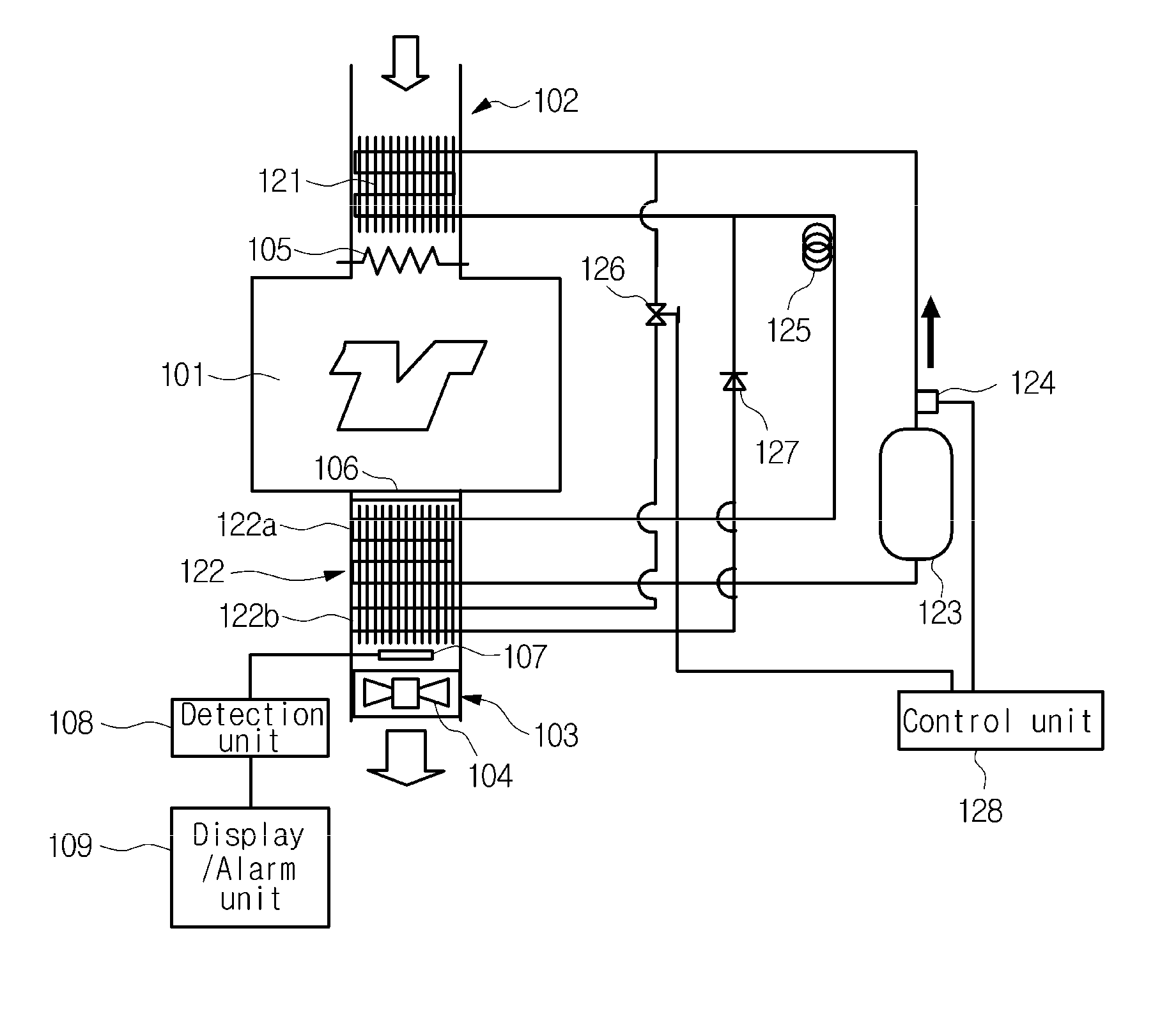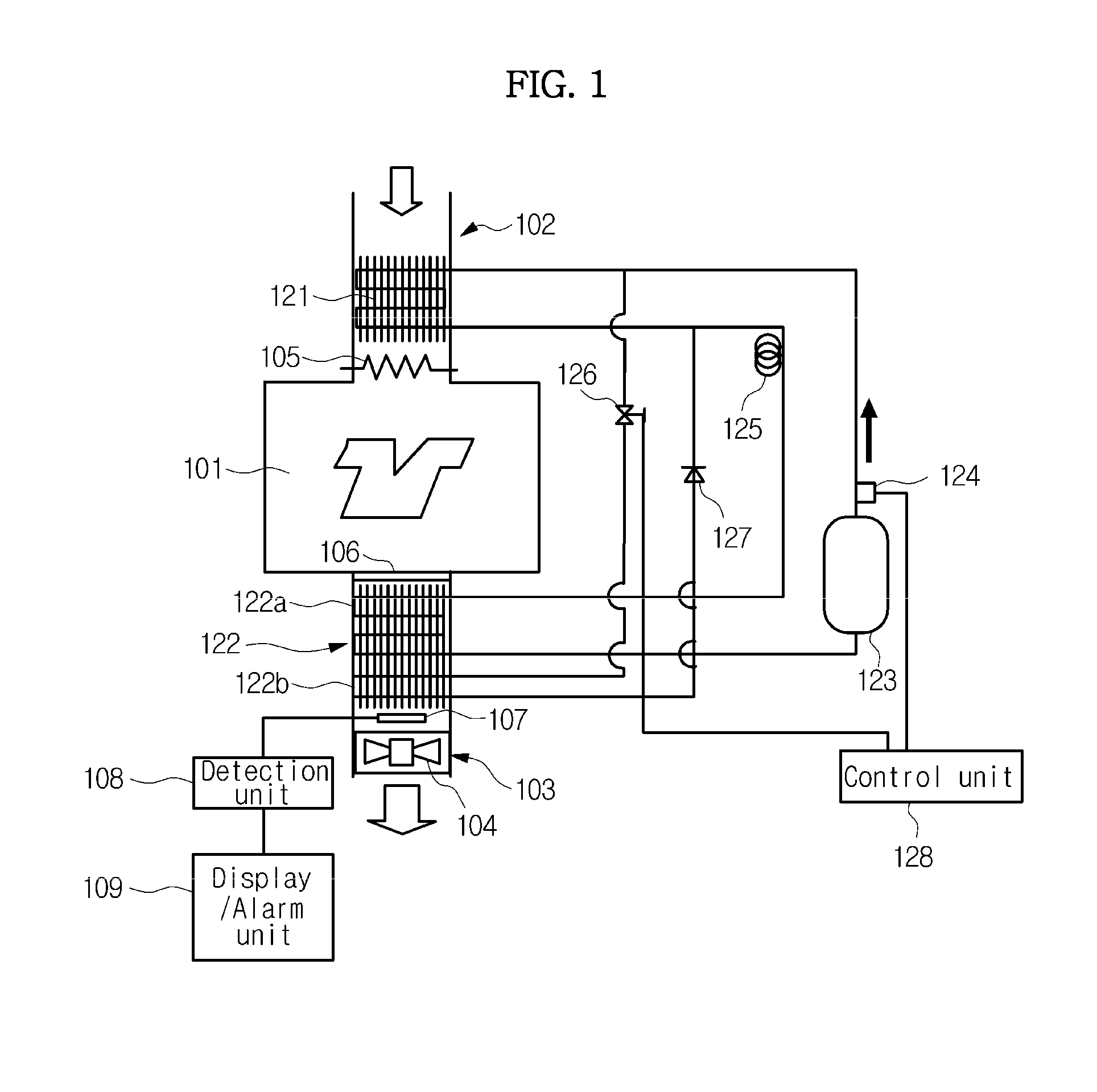Clothes dryer
- Summary
- Abstract
- Description
- Claims
- Application Information
AI Technical Summary
Benefits of technology
Problems solved by technology
Method used
Image
Examples
first embodiment
(Configuration of Clothes Dryer)
[0119]As shown in FIG. 1, a clothes dryer has, for example, a drying chamber 101 constituted by a rotary drum, a suction passage (an air passage) 102 and an exhaust passage (an air passage) 103, and air is flowed by a blower 104 to dry clothes in the drying chamber 101. A first condenser (a suction-side heat exchanger) 121 and a heater 105 of a heat pump are installed at the suction passage 102. In addition, a filter 106, an exhaust-side heat exchanger 122 and a flow velocity sensor 107 (to be described below) are installed at the exhaust passage 103. A display / alarm unit 109 is connected to the flow velocity sensor 107 through a detection unit 108. The exhaust-side heat exchanger 122 is constituted by an evaporator 122a and a second condenser 122b.
[0120]The heat pump is further constituted by a compressor 123, a refrigerant pressure sensor 124, a decompressor 125, a flow rate regulator 126, a check valve 127 and a control unit 128, in addition to th...
second embodiment
[0163]A clothes dryer 100 of a second embodiment is a suction / exhaust type, and as shown in FIG. 24, includes a drum 2 configured to accommodate clothes, a suction flow path 3 configured to suction air into the drum 2, an exhaust flow path 4 configured to exhaust the air from the drum 2, a heat pump circuit 5, and a control unit 6 configured to control the respective parts of the clothes dryer 100. In addition, a heater 7 configured to auxiliarily heat the suctioned air is installed at the suction flow path 3.
[0164]The heat pump circuit 5 has a main circuit 5a to which a compressor 53, a first condenser 54a, a decompressor 55 and an evaporator 56 are sequentially connected in a loop shape, and a sub-circuit 5b branched off between the compressor 53 and the first condenser 54a at the main circuit 5a, to which a refrigerant flow rate regulator 58, a second condenser 54b and a check valve 59 are sequentially connected, and joining the first condenser 54a and the decompressor 55. In add...
third embodiment
[0179]As shown in FIG. 27, in a clothes dryer of a third embodiment, the second condenser 54b is branched off between the first condenser 54a and the decompressor 55 of the main circuit 5a, the sub-circuit 5b joining the intersection and the decompressor 55 is provided, and a circuit switching device 60 configured to branch off the sub-circuit 5b from the main circuit 5a is installed at the intersection of the heat pump circuit 5. During normal operation, when a sub-circuit-side outlet of the circuit switching device 60 is closed and the refrigerant temperature or refrigerant pressure in the heat pump circuit 5 arrives at a predetermined level or more, the sub-circuit 5b side of the circuit switching device 60 is opened to decrease the refrigerant temperature and refrigerant pressure in the heat pump circuit 5. Another configuration is similar to the second embodiment, and detailed description is incorporated from the second embodiment. In addition, the same reference numerals desig...
PUM
 Login to View More
Login to View More Abstract
Description
Claims
Application Information
 Login to View More
Login to View More - R&D
- Intellectual Property
- Life Sciences
- Materials
- Tech Scout
- Unparalleled Data Quality
- Higher Quality Content
- 60% Fewer Hallucinations
Browse by: Latest US Patents, China's latest patents, Technical Efficacy Thesaurus, Application Domain, Technology Topic, Popular Technical Reports.
© 2025 PatSnap. All rights reserved.Legal|Privacy policy|Modern Slavery Act Transparency Statement|Sitemap|About US| Contact US: help@patsnap.com



